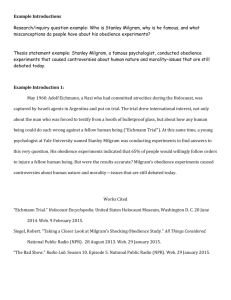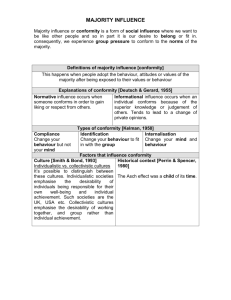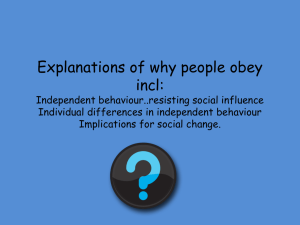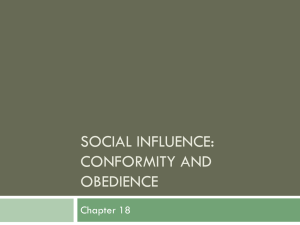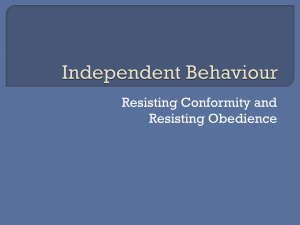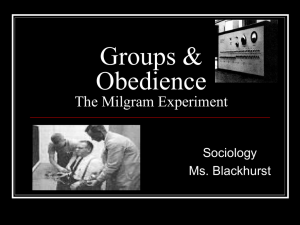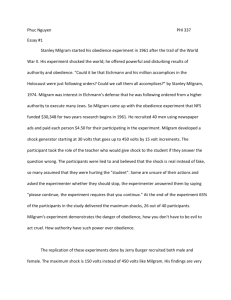Evaluation PowerPoint
advertisement
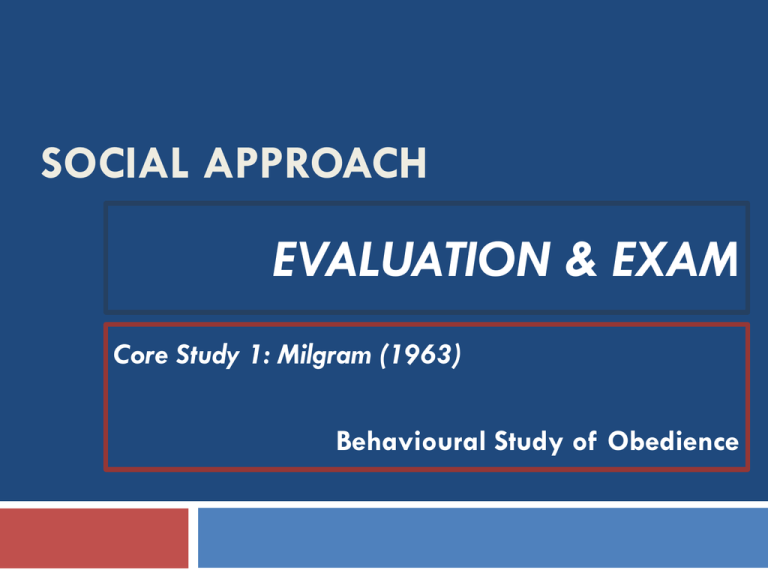
SOCIAL APPROACH EVALUATION & EXAM Core Study 1: Milgram (1963) Behavioural Study of Obedience Reflecting on the study... The research suggests that obedience is influenced by the social environment we are in, could there be another way to explain obedience? (HINT: Personality, gender, genetic factors) Milgram study is a cross between a controlled observation and a laboratory experiment. What do you think is good about using this technique? Milgram used forty male participants aged between 20-50 years old. Is this a representative sample? Explain your response. Evaluation Questions 1. 2. 3. 4. What did Milgram conclude? Why did participants obey? What are the strengths and weaknesses of the method used in relation to the study? Identify the sampling technique? Was it representative? What are the strengths and weaknesses of the data gathered in relation to this study? 5. Was the study ecologically valid? 6. What ethical issues were raised by the study? 7. Was the study useful? Can it be applied to everyday life? 8. Comment on the reliability of the study 9. Comment on the validity of the study 10. Describe one change that you would make to this study and explain how you think this might affect the outcome? 1. What did Milgram conclude? 1. Why did participants obey? 2. What are the strengths and weaknesses of the method used in relation to the study? 3. Identify the sampling technique? Was it representative? 4. What are the strengths and weaknesses of the data gathered in relation to this study? 5. Was the study ecologically valid? 6. What ethical issues were raised by the study? 7. Was the study useful? Can it be applied to everyday life? 8. Comment on the reliability of the study 9. Comment on the validity of the study 10. Describe one change that you would make to this study and explain how you think this might affect the outcome? ADDITIONAL POINTS Dispositional Vs Situational •Nature Nurture •Ethnocentricism • Dispositional Vs Situational Dispositional hypothesis: The idea that a person’s characteristics determine their behaviour e.g. personality traits. Situational hypothesis: The idea that conditions in a situation determine behaviour e.g. orders from an authority figure. In this study Milgram believed that the situation the person was in determined their behaviour (being in a prestigious university, being with an authority figure etc). Nature-Nurture The study suggests that our behaviour is explained by ‘nurture’ rather than ‘nature.’ This is because the presence of an authority figure, the location affected the participants behaviour. This suggests that our situation/environment affects our behaviour rather than our biology/genes. Ethnocentricism Study is based on Western culture and assumes everyone will be the same – though generalisations should not be made. This can lead to ethnocentrism (biased towards certain group). However, the levels of obedience for the American sample were so high that it was not necessary to test any other nationality; therefore the sample was deliberately ethnocentric. Other psychologists have tested subjects from many cultures and found that people generally obey figures of authority regardless of culture. Exam Style Questions Exam Help Some top tips.... Know the research method and sample Know the procedure in relation to the teacher, learner, experimenter? Know the key findings Know at least three explanations for Milgram’s findings Be able to suggest at least one way in which the study could be improved, and possible implication of the suggestion(s) for methodology, ethics, reliability, validity, usefulness, practicality and so on. Exam Help Issues to be considered... Strength/Weaknesses of conducting research under controlled conditions Strength/Weaknesses of a snapshot study Strength/Weaknesses of observations and self-reports as a way of gathering data Strength/Weaknesses Q&Q data Strength/Weaknesses of the sample Reliability Validity including ecological validity Ethics Section A: Practice Questions 1. Identify two features of the sample (2) 2. Outline one limitation of the sample (2) 3. Describe how the sample was gathered (4) 4. Identify two ways in which the participants were deceived (4) 5. Explain the benefits of deception as used in this study (2) 6. 7. Outline one way in which this study may be considered high ecological validity (2) Outline one way in which this study may be considered low ecological validity (2) 8. Describe why this study can be considered a controlled observations (4) 9. Describe one piece of quantitative data gathered in the this study (2) 10. Describe one piece of qualitative data gathered in the this study (2) Section A: Exam Questions 1. January 2009 Describe how the sample used. (2) Outline one limitation of this sample. (2) 2. June 2009 Describe how the sample was obtained. (2) Outline one disadvantage of the way this sample was obtained. (2) 3. January 2010 Describe how obedience was measures. (2) Suggest one problem with measuring obedience in this way. (2) Section A: Exam Questions 4. June 2010 Identify two findings from this study. (2) Outline one explanation Milgram gave for his findings. (2) 5. January 2011 Outline two features of the Milgram study of obedience which made it seem real to the participants. (4) 6. June 2011 Outline two ways in which Milgram’s study of obedience can be said to low in ecological validity. (4) 7. January 2012 Milgram, in his study of obedience, offered several suggestions for why participants obeyed. Describe two of these suggestions. (4) Section A: Exam Questions 8. June 2012 Outline two qualitative findings from this study. (4) 9. June 2013: Explain why many participants displayed signs of severe stress and emotional strain. (4) 10. January 2013 Identify two results from the above table. (2) Outline one conclusion that could be drawn from the above table of results. (2) 11. June 2014: From Milgram’s study of obedience: Describe two ways in which participants in this study were deceived. (4) Section B: Practice Questions a. b. c. d. e. f. Describe why this study was conducted (4) With reference to this study, describe one strength and one weakness of quantitative data (6) With reference to this study, describe one strength and one weakness of qualitative data (6) Describe how obedience was measured in this study (6) Outline three key findings of this study (3) Describe ways in which this study could be improved (8) Section B: Exam Questions 12. January 2009: Briefly outline the previous research or event which was the stimulus for your chosen study. (2) Describe how the sample was chosen study was selected and suggest one advantage of this sample. (6) Explain why your chosen study can be considered a laboratory experiment. (6) Give one advantage and one disadvantages of conducting your chosen study in a laboratory. (6) Suggest how your chosen study could be improved. (8) Outline the implications of the improvements you have suggested in your chosen study. (8) Section B: Exam Questions 13. January 2012 a. Outline the aim of your chosen study? (2) b. Describe the sample used in your chosen study and suggest one advantage of using this sample. (6) c. Describe how observation was used in your chosen study. (6) d. Suggest one strength and one weakness of using observation in your chosen study. (6) e. Outline the findings of your chosen study. (6) f. Identify and evaluate two possible changes to your chosen study. (8)
